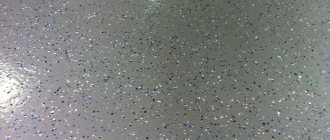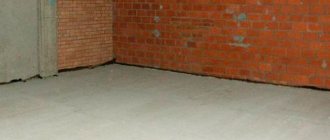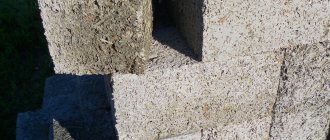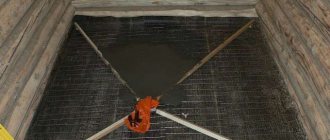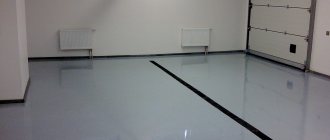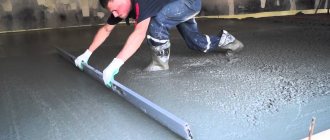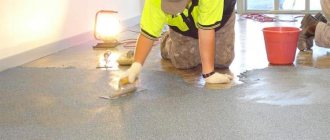The floor in the garage experiences mechanical stress and chemical influences of various kinds. Therefore, concrete is used when arranging the floor. It is practical and inexpensive, the main disadvantage of this floor is the occurrence of cement dust during use, which will cause a lot of trouble, especially when repairing a car. The optimal solution is to coat the base with concrete floor paint.
Painted garage floor
Pros and cons of concrete garage floors
Before you figure out how to paint a concrete garage floor, it’s worth learning about the features of this type of floor finish. Among the advantages:
- Strength and resistance to stress. Concrete is used in garages, factories, warehouses, production facilities, and anywhere with intense load.
- Durability – if the installation technology is followed, the service life is 20-30 years.
- Practicality – components for concrete floors are available and cheap. To eliminate defects, you need to fill in a new screed of small thickness.
- Hygiene and safety – using concrete for a garage floor will allow you to forget about the problem of static electricity accumulation. The structure of concrete is such that it does not allow microorganisms, bacteria, and fungi to penetrate inside the screed.
There are also disadvantages, among them:
- The material has a porous structure, so mechanical damage leads to the formation of dust. The floor is peeling, and an unpleasant gray dust covers everything. This dust is dangerous because it can damage the respiratory system if inhaled.
- The gray concrete floor of garages does not look aesthetically pleasing. But this is not a critical drawback for such a room.
- Water permeability, sensitivity to individual chemical compounds that are included in gasoline, oils, and auto chemicals. If concrete is regularly exposed to such influences, the floor will collapse within a couple of months. To eliminate this, it is necessary to cover the floor with paint.
- The occurrence of cracks, subsidence, roughness, chips.
Choosing paint is not an easy task
Installation of rubber flooring
Another way to solve the dust problem is to lay some kind of covering on top of the concrete floor, for example, rolls or rubber tiles. In the case of rolls, installation of the coating is most reminiscent of laying linoleum. In the second case, the rubber tiles are simply laid joint-to-joint and secured with special locking joints.
Both options do not require special knowledge, effort or time. Unfortunately, these qualities are compensated by the high price of the material, so rubber coating is used quite rarely.
Why do dust and other defects appear?
The wear of the concrete base occurs more intensely, and more dust is generated in the following cases:
- If the car drives in and out of the garage every day.
- High humidity. The garage doesn't always have heating, and if it does, it doesn't work all the time. Therefore, in autumn and winter the room is humid, which does not have the best effect on the condition of the concrete floor.
- Low temperatures.
- The influence of chemicals, especially auto chemicals and fuels and lubricants.
Note! The painted floor is not subject to negative influences. In addition, covering a concrete floor in a garage will cost less than pouring a new screed.
Method 2. Painting
Concrete paint is a quick, convenient option, and you can choose any color that will please the eye for a long time. Such a floor will be waterproof, durable, and smooth. It is recommended to use paint for applying road markings - if it can withstand thousands of wheels and weather changes daily for a long time, then it will definitely cope with one car in the garage.
The floor can also be covered with latex, polyurethane, epoxy, alkyd, or oil paint. The difference is in price and drying time; select based on your own capabilities and preferences.
Paint selection
Concrete garage floor paint must be able to withstand the elements, moisture and chemicals. Another factor is the ability to create a dust-free surface that can withstand temperature changes and abrasion.
There are many options for covering a concrete floor in a garage: epoxy, polyurethane, acrylic and alkyd paints, primers. Each composition has its own specifics, advantages and disadvantages.
Latex acrylic paints
This option for covering a concrete floor in a garage is convenient. This is an aqueous solution, based on acrylic resins, polymers, and does not emit a strong odor when painting, since the room is small and enclosed - this is important.
Painting with latex acrylic paints has the following features:
- Protection from mechanical damage, abrasion, chemicals, increases and decreases in temperature, and humidity.
- Compositions for concrete take into account the characteristics of the material.
- Maintaining an attractive appearance to the surface.
- The paint is environmentally safe.
- Can be applied with a brush, roller, or spray.
- Dries in 12 hours.
There is only one drawback - the high price.
The paint on the floor looks impressive
Polyurethane enamel
This coloring composition is capable of protecting concrete both inside and outside the garage. Some properties and features:
- The surface coated with polyurethane enamel is resistant to atmospheric influences and temperature changes.
- High covering power.
- Painting a concrete floor in a garage with this paint will ensure strength, durability, and excellent resistance of the concrete.
- The price is affordable.
Disadvantages: demanding application conditions. The air temperature is above +5⁰, and the humidity is not higher than 75%.
The specificity of two-component compositions is that you need to paint the floor in two passes. Mix the paint components and apply the second layer every other day. Before you paint a concrete floor with this enamel, you need to think about where to leave the car for 2 weeks. It dries so much. Although you can walk on it after 2 days, it is not advisable to bring a car.
Epoxy paints
To remove dust from a concrete floor in a garage, the store will recommend this paint. After application, the coating becomes durable and strong. The appearance remains attractive even with daily use. She has the following positive aspects:
- It has high waterproofing abilities.
- Adhesion to concrete at a high level.
- Resistance to the influence of precipitation.
- Resistant to abrasion and yellowing regardless of color.
- Can be easily applied to concrete that has not completely hardened.
Expensive, but the price justifies the quality. Since the paint is permanent, it will not be possible to change the color of the floor after painting.
Paints may have different colors
These paints are available in two types:
- One-component - require a primer coat before painting.
- Two-component - the components are mixed before application. These are more expensive than the first type and are difficult to apply.
Other paints
You can find such options that theoretically remove dust from the floor in the garage:
- Alkyd.
- Oily.
- Organofluorine.
Note! They are not the best option, since after contact with flammable substances they quickly crack and change color, leaving the concrete without protection. This happens because they contain soluble resins.
Surface dust removal technology using impregnation
Before applying impregnation to concrete, the floor must be treated with a grinding machine. This is done to remove the top destroyed layer, cement laitance, traces of dirt and oils, while simultaneously leveling the surface.
Sanding can be done on a damp or dry base. The latter option is characterized by high productivity and the ability to control the process. The wet sanding method produces a well-polished surface.
Before treating a concrete floor with impregnation, it must be sanded.
Note! Treating the floor with a grinding machine helps open the pores of the concrete base, which improves the efficiency of penetration of the composition into the thickness of the surface and forms persistent chemical compounds.
Any impregnation is applied using a fluffy roller, brush or spray. The composition is poured onto the prepared base in strips. It is necessary to ensure uniform filling of the entire surface area. There should be no places where the composition is quickly absorbed into the concrete, or areas with minimal saturation where puddles have formed. The inorganic composition is applied in one layer.
The base must be coated twice with polymer impregnations. The composition is evenly distributed over the surface using a squeegee or silicone roller. After 30-50 minutes, a second layer of the mixture is applied. The surface must dry for 20 minutes. After time, all excess impregnation should be removed with a rag.
After 24 hours, the hardened and dust-free surface can be painted with polyurethane-based enamel, which is applied in two layers. After 24 hours, the surface is suitable for use. The price for dust removal of a concrete floor using impregnations starts from 800 rubles/m².
Concrete floors must be treated with polymer impregnations twice.
Note! The surface dust-free by impregnation is characterized by several times increased strength, which depends on the quality of the original concrete base.
Primers
Primers are used to prepare the surface for painting, but some, such as polyurethane and epoxy, will be an excellent replacement for paint if the goal is dust removal.
The garage is the car’s home, and it should be comfortable
Use if there is no need for painting. Polyurethane primer has specific features:
- Can fill the pores of concrete, making it durable.
- High level of adhesion to concrete.
- You can apply it either with a brush or with a roller.
- Dries quickly.
- Protects concrete from negative influences typical of a garage.
As for epoxy, it also has features, including:
- After application, a dense film appears on the surface, which seals the pores.
- Does not allow moisture to reach the concrete floor.
- After drying it has an attractive shine.
- Helps make the surface stronger, protecting against wear and friction.
Method 4. Polystyrene foam
This method does not involve covering the floor with polystyrene foam (although this is probably also an option), but... pouring it. You will need pieces of foam plastic and a solvent (xylene). Dissolve the first one with the second one until it dissolves.
Pour the resulting solution onto the concrete floor, level it, and dry. You can also add dye to the mixture if desired. The method is very affordable and budget-friendly. However, it is not indisputable. Thus, gasoline also acts as a solvent for polystyrene foam. Therefore, if you spill a little fuel on the treated floor, you can get something sticky.
Attention! With this method, you need to be careful when working with chemical compounds. Don't forget about protective equipment.
Paint/Primer Application Steps
Regardless of which material is chosen for dust removal, the process of applying the composition is the same and consists of the following steps:
- Preparing the base. If necessary, seal gaps and cracks. If the defects are serious, then pour the concrete with a thin layer of self-leveling mixture.
- Check humidity. To do this, use a simple test: stick a piece of polyethylene measuring 10x10 cm onto concrete using tape and leave it for a day. If condensation appears during this time, the concrete is not ready for painting. The only exception is the use of epoxy paints.
- Coloring in accordance with technology.
- Drying, applying an additional layer as necessary.
Remove defects before applying paint
Coloring
As an alternative to impregnation, conventional staining is often used. With this method, a primer is first applied to the concrete surface (usually 2 layers). It is then covered with a layer of paint, which forms a barrier between the environment and the concrete, preventing the latter from collecting dust.
Important! Painting is often presented as a budget alternative to other methods of concrete dust removal. However, it should be understood that in practice, savings are only possible when using low-quality or unsuitable materials. Specialized paints and primers for removing dust from concrete are quite expensive.
How does dust removal occur?
Physical impact on the surface of a concrete ceiling leads to the fact that it begins to gather dust and wear out. If the technology was violated when laying the floor or low-quality concrete was used, a large amount of dust is generated.
For dust removal, two methods are used, which are based on impregnations of a special composition: inorganic and organic.
These methods are equally effective and are used in certain conditions. Organic impregnations are based on polyurethane, epoxy resin, and acrylic. Microvoids in concrete are filled with organic substances, and due to this, its porosity is reduced. As a result, the concrete structure is compacted and dust removal occurs. Inorganic impregnations are based on flats that act on concrete. Chemical transformations convert soluble surface compounds into insoluble coatings. As a result, the outer layer is strengthened, resists mechanical stress better and does not generate dust.
How to remove dust:
- During the process of laying concrete, no finishing coating is provided;
- During operation or after laying concrete, treating the surface with special compounds;
- If the surface has a high degree of exploitation (production, warehouses), then in order to protect it from destruction, this work is carried out constantly;
These two methods of removing dust from the surface also increase resistance to moisture, frost and aggressive substances, wear resistance, and enhance hygienic qualities.

